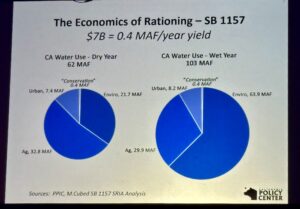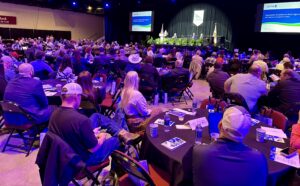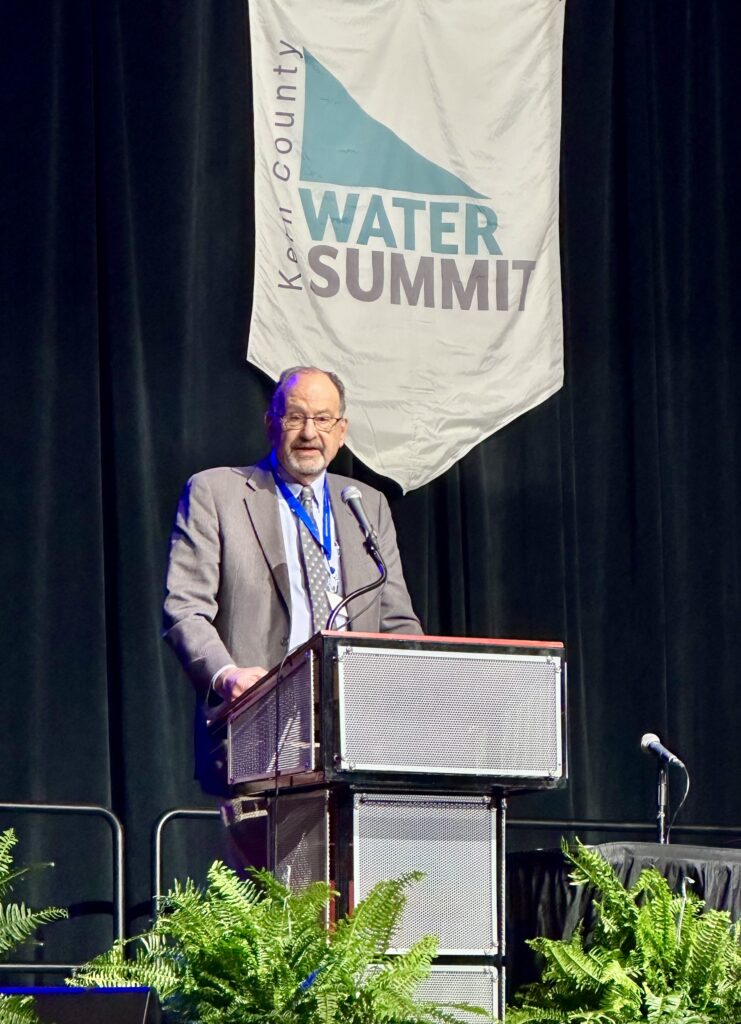With nature providing plenty of water – finally – this year, and groundwater regulation well underway, water managers, farmers and others turned their focus to infrastructure at Thursday’s Water Summit put on by the Water Association of Kern County.
Early in the day’s line up of speakers, Edward Ring, senior fellow with the California Policy Center, captured the audience’s attention with an extensive cost-benefit analysis of the Delta Conveyance project, a tunnel that would take Sacramento River water beneath the ecologically sensitive Sacramento-San Joaquin Delta 45 miles to be exported south.
His conclusion: the project has a whopping price tag for a “dribble” of water.
Though the Department of Water Resources, which is in charge of the project, has estimated it will cost $16 billion, environmental groups have disputed that, saying the true cost is closer to $56 billion.
After studying the project, Ring said the cost is likely somewhere around $30 billion and will result in 500,000 acre feet per year, at best.
Comparatively, that same $30 billion could be used to create 1 million acre feet through wastewater treatment; or 1.1 million acre feet by funding more desalination plants; or 1.5 million acre feet by building and enhancing five surface storage facilities, with enough left over to repair aqueducts and rebuild levees.
“When you look at where the state is putting its financial eggs…it’s a very inefficient use of money,” Ring said.
As for conservation efforts, he said, $7 billion in investments would only yield an additional 400,000 acre feet a year statewide.

More bang for the bucks
Ring also pointed to what he felt was potentially the most cost effective way to produce more water from the delta without harming fish, a concept known as filtration beds. The idea is being promoted by the Water Blueprint, a coalition of mostly San Joaquin Valley ag and water organizations. The Blueprint estimates $5 billion could yield 2 million acre feet a year, according to Ring’s presentation.
The concept involves building several large recharge basins along the delta. Perforated pipes buried beneath a gravel bed would allow water to move by gravity into collection areas so it could be exported south.
Under this more passive scenario, natural delta flows wouldn’t be interrupted as they are when powerful pumps are used to suck thousands of acre feet of water into canals. The price to build three or four filtration beds that could move as much water as the proposed tunnel would be minuscule in comparison, he said.
“The state could still work on its tunnel and spend a couple million on a (filtration bed) pilot project,” he said
Sinking canal rebuild
A project to rebuild a portion of the Friant-Kern Canal is nearly complete despite being overrun by flood waters last year and suffering more subsidence, according to Johnny Amaral, Chief Operating Officer of Friant Water Authority.
The 152-mile long canal carries water from Millerton Lake down to users in Kern County. But overpumping caused it to sink along a 33 mile section south of Pixley. That sag reduced its capacity by 60% in some areas.
Friant had to build an entirely new canal just east of the existing one for 10 miles. That portion is now complete and water is once again being delivered through that section.
Last year’s historic flooding inundated construction when the Deer River breached levees. The flood submerged vehicles and washed out entire areas of the new construction, Amaral said.
“This was a nightmare and it was a nightmare for quite some time,” said Amaral. “Deer Creek just had a mind of its own last year.”
The flooding even led to some changes in the project. Piping was installed in some of the construction areas to help move water if Deer Creek floods again.
Private water banking raises questions
Water storage was another popular topic. A panel of experts spoke about the importance of water banking and how it functions in the San Joaquin Valley.
Eric Averett, CEO of Atlas Water LLC. and former general manager of the Rosedale-Rio Bravo Water Storage District, raised questions about where water banking could be headed.

There is momentum for landowner managed water banking, said Averett. Many agencies have created policies to make water banking easier for landowners, he said. But that raises questions such as, how available supplies will be allocated? And whether public water districts will have to compete with private landowners or supplies?
“Don’t shoot the messenger.”
The keynote speaker, Dee Dee D’Adamo, Vice Chair of the State Water Resources Control Board, tackled the elephant in the room – pending hearings to determine if the state should take over groundwater pumping in valley regions.
“All eyes are gonna be on us,” she said of an upcoming April 16 hearing for the Tulare Lake subbasin, which covers most of Kings County.
All southern San Joaquin Valley subbasins, including Kern, are considered critically overdrafted after allowing too much groundwater pumping. And most of those same areas had plans to correct the problem rejected by the state.
Now the Water Board is poised to possibly put regions into “probation,” which would mean state bureaucrats would determine how much landowners can pump and charge steep fees in the process.
Next, the Tule subbasin, which covers the southern portion of Tulare County, will be heard in September, then the Kaweah in November and Kern will come before the board in January 2025.
A report with the Water Board staff’s recommendation on whether to put Kern on probation will come out this spring. D’Adamo urged the crowd to take the critiques from the state seriously and to try to address those issues in the groundwater plan.
“I have every faith that you can do that,” said D’Adamo. “Don’t shoot the messenger.”
Share this:
- Click to share on Facebook (Opens in new window)
- Click to share on Twitter (Opens in new window)
- Click to share on LinkedIn (Opens in new window)
- Click to share on Reddit (Opens in new window)
- Click to share on Tumblr (Opens in new window)
- Click to share on Pinterest (Opens in new window)
- Click to share on Pocket (Opens in new window)
- Click to share on Telegram (Opens in new window)
- Click to share on WhatsApp (Opens in new window)
- Click to print (Opens in new window)









You must be logged in to post a comment.